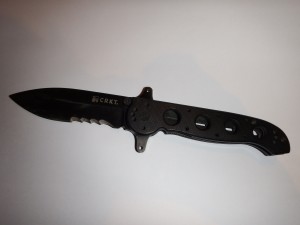Picking the Perfect Knife for You, by B.A.
Posted by admin on Oct 23rd 2014
Picking the perfect knife for you
 A lot of times, when I’m deciding on my next knife, I spend as much time researching and comparing as I did helping plan my own wedding. (I’m talking about napkins and crap, not my wife.) There are a lot of things to consider and narrowing it down can be a grueling job if you over-think it like I do. Here are some things that have helped me figure out exactly what I want in a knife:
A lot of times, when I’m deciding on my next knife, I spend as much time researching and comparing as I did helping plan my own wedding. (I’m talking about napkins and crap, not my wife.) There are a lot of things to consider and narrowing it down can be a grueling job if you over-think it like I do. Here are some things that have helped me figure out exactly what I want in a knife:
1. USE: The most important thing you will want to consider is what you will be using it for. Is it a tool, for self defense, survival, hunting, or a time consumer like a butterfly knife? When you know exactly what it is you intend to use it for, it makes it much easier to select the category to start and this will get you pointed in the right direction. (No pun intended.) It is vital however, that no matter what you plan to do with it, you know how. Study up on how to properly handle it. This could be knowing how to efficiently gut an animal or resorting to it as a line of defense. Taking it out and not being trained in how to employ it could result in more trouble than it was worth in the beginning. Knives are to be respected as the weapon they are. Many knives can be multipurpose and cover a couple of these categories. My suggestion is that you utilize it for the purpose it was created but know its limits. A folder knife doesn’t really make a great hunting knife because they aren’t fun to clean and aren’t as reliable as a full tang (blade goes the entire length of the handle) which can also be used in a survival situation to chop wood or throw with less chance of breaking. However, walking around with a machete hanging off your waste tends to give people a bad impression of you. And I’m sure you’re a real decent person.
2. BLADE: As I said before, a full tang blade is much more reliable and will hold up through whatever you throw at it. On the other hand, a good folder can tuck comfortably in your pocket and give you a subtle extra hand in almost any situation. Be sure to check local laws if you plan to carry a knife concealed on your person. In most cases, the blade must be shorter than 4 inches and have a pocket clip to remain visible. I know this is especially true in California where all their laws are whack but in Utah, where I live, I have talked to several authorities and the general consensus here is that as long as you can justify it as a useful tool and that you aren’t just carrying it with intent to do harm then it is alright. The guy who did my concealed carry class told me that the permit does not cover knives and that I would have to research that separate. I still haven’t found anything saying otherwise so don’t quote me on it, but that’s all I know.
A few things to consider are the type of steel, the type of blade, number of blades, and length. Most common knives you find have a standard stainless steel or 440. There are 3 types of 440 steel. 440A, 440B and, you guessed it, 440C. C is the best and also the most expensive. If it isn’t specified which, you can assume that it is A. Any of these metals will work for day to day functions but can be considered essentially base grade. If you really want to invest, you can look into more upscale metals like s30v or v10. Those are just some more common types. There is also Damascus (real Damascus hasn’t been made for centuries since the recipe was lost) which is very strong, and titanium which is weaker but won’t rust making it great for diving knives. You may want to go with a multi-tool if you’re looking for practicality. I’ll swear up and down on the Leatherman Wave but the Surge is a close second. A Swiss army knife is also a good alternative. This gives you multiple blade options for more specific jobs. Remember that every blade eventually goes dull. Invest in a honer and sharpener and then learn how to properly use it. Benchmade makes a great honer and Spyderco a great V design sharpener, both available at Bladeops.com. A good point here is to think about the fact that it is much harder to sharpen a serrated blade. They are practical in that they can cut tougher materials but lack the surgical precision of a straight blade. And finally, you need to think about what style you are looking for. I have a trailing point blade that I use for gutting ducks, my deer knife has a gut hook, my butterfly knife has a tanto which is more handy for day to day jobs, and my all purpose daily carry is a drop point which I find better for self defense and it better fits my personal needs. A few other types include: the clip point, pen style, needle point, spear point, and hawkbill. Each was created for its own purpose but have fairly specific jobs.
3. MECHANISM: This is where personal taste and style really come into play. If you want your knife to have panache, an assisted knife allows quick access and cool presentation. Out the Front or OTF knives are a great example. However, pig stickers like the balisong butterfly knives serve little purpose other than to impress or intimidate, if that’s your game, showoff. They require a process to access and freak most people out but are a fun talent to master and teach you a sick sort of serenity. It’s kind of like how martial arts are supposed to bring you a kind of enlightenment. I do suggest that if you go this route to pick one held together with pins rather than screws. I’ve had many a butterfly explode on me after playing with it too long. People like screws because you can adjust it to your preferred tightness tolerances but if you do go that way, use lock-tite to keep the screws in place.
A full tang knife can hang from your belt or you can carry a lock blade in your pocket. It’s all personal preference. Lock knives have a wide variety of options. Cold Steel have a very reliable lock back that they advertise with military personnel swinging from knife to knife like monkey bars. Very common is the liner locker style which can be a trick at times but I find more reliable. And then there’s the lever lock or button lock which has a switch on the side of the handle to release it. It’s all about finding your price range and knowing what you like. If you can only afford $65 then don’t play with a $300 knife. After that, everything in your range will feel like garbage. More popular brands will usually offer better quality. That’s what got their name to where it is. A few noteworthy brands are: Gerber (Don’t buy it just because Bear Grylls posted his face all over it), Benchmade, Buck, Kershaw, Shrade, Boker, Spyderco, SOG, Cold Steel, K-Bar and CRKT. Go with what looks good to you. Find what fits your hand and something that you can see owning for a long time. Who said you had to have just one? I own over 70. Granted, for some that may be excessive, but each has a function, a specific purpose, and better yet –a story.
After a long excessive trial and error period of many years, I have decided that the CRKT M21 -14SFG “Big Dog” is the pocket knife that works best for me. CRKT is a fairly new company but has already made itself an outstanding reputation with 15 patents under its belt. I was looking for a heavy duty blade that could take a beating to perform any mechanic work I may use it for and double as a personal defense. The reasons this one won out over so many others was primarily the hilt. The number one injury in a knife fight is actually your fingers slipping up onto the blade and cutting you all up. Having the hilt prevents this but it also allows me to quickdraw the knife from my pocket. When I pull it out, it catches in the corner and pulls the blade open. The only other knife I’ve seen with this option is the Emerson series by Kershaw. I had to change the position of the pocket clip to permit this but the nice thing is that it has 4 possible clip locations for left or right handed handlers. Use lock-tite on the screws when switching it. Another plus is that it is not an assisted knife, but by applying a lot of pressure with my forefinger to the hilt on the back of the closed knife and then releasing the blade with the other fingers, I am able to make it spring open as if it were. It is perfectly balanced which also gives it the potential to make a good throwing knife if it came to that, and I throw it often to get the feel down. It is a steel frame and has a 8Cr14MoV blade with nitrade coating. In English that means that it holds up better than an aluminium construction and is resistant to corrosion. From tip to bottom it is about 9.25 inches. It’s a standard crocodile Dundee. It was designed based on the requests of military procurement specialists. This is just the one that works best for me and I wanted to explain why. I hope this has all helped save some money and time in figuring out what you’re looking for. All I can say is find what satisfies your taste and needs. It’s ok to have more than one.

